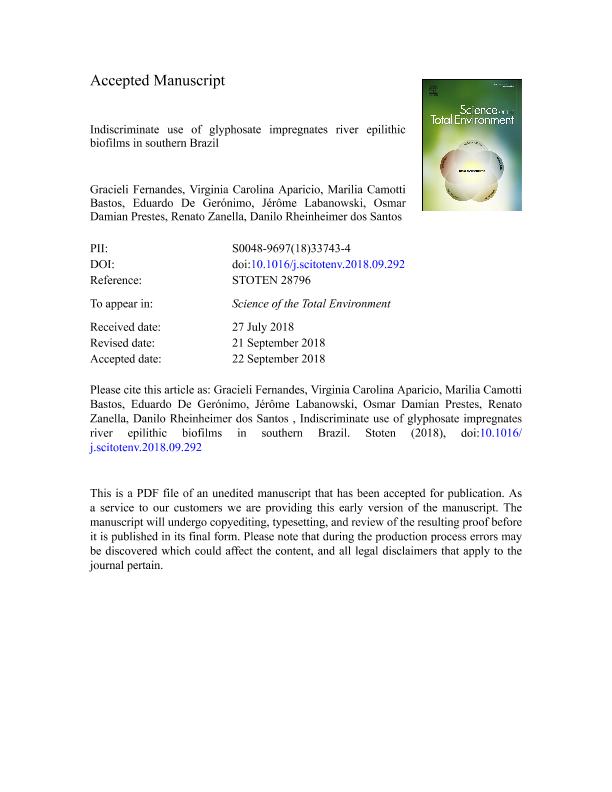Mostrar el registro sencillo del ítem
dc.contributor.author
Fernandes, Gracieli
dc.contributor.author
Aparicio, Virginia Carolina

dc.contributor.author
Bastos, Marilia Camotti
dc.contributor.author
de Gerónimo, Eduardo

dc.contributor.author
Labanowski, Jérôme
dc.contributor.author
Prestes, Osmar Damian
dc.contributor.author
Zanella, Renato
dc.contributor.author
dos Santos, Danilo Rheinheimer
dc.date.available
2019-09-13T15:12:26Z
dc.date.issued
2018-09
dc.identifier.citation
Fernandes, Gracieli; Aparicio, Virginia Carolina; Bastos, Marilia Camotti; de Gerónimo, Eduardo; Labanowski, Jérôme; et al.; Indiscriminate use of glyphosate impregnates river epilithic biofilms in southern Brazil; Elsevier Science; Science of the Total Environment; 651; 9-2018; 1377-1387
dc.identifier.issn
0048-9697
dc.identifier.uri
http://hdl.handle.net/11336/83525
dc.description.abstract
Epilithic biofilms are communities of microorganisms composed mainly of microbial cells, extracellular polymeric substances from the metabolism of microorganisms, and inorganic materials. Biofilms are a useful tool to assess the impact of anthropic action on aquatic environments including the presence of pesticide residues such as glyphosate. The present work seeks to monitor the occurrence of glyphosate and AMPA residues in epilithic biofilms occurring in a watershed. For this, epilithic biofilm samples were collected in the Guaporé River watershed in the fall and spring seasons of 2016 at eight points. Physicochemical properties of the water and biofilms were determined. The determination of glyphosate and AMPA was performed using an ultra-high performance liquid chromatograph coupled to a tandem mass spectrometer. The concentrations of glyphosate and AMPA detected in epilithic biofilms vary with the season (from 90 to 305 μg kg−1 for glyphosate and from 50 to 240 μg kg−1 for AMPA, in fall and spring, respectively) and are strongly influenced by the amount of herbicide applications. Protected locations and those with poor access not demonstrate the presence of these contaminants. In the other seven points of the Guaporé River watershed, glyphosate was detected in concentrations ranging from 10 to 305 μg kg−1, and concentrations of AMPA ranged from 50 to 670 μg kg−1. An overview of the contamination in the Guaporé watershed shows that the most affected areas are located in the Marau sub-watershed, which are strongly influenced by the presence of the city of Marau. This confirms the indiscriminate use of glyphosate in the urban area (weed control, domestic gardens and horticulture) and constitutes a problem for human and animal health. The results showed that biofilms can accumulate glyphosate resulting from the contamination of water courses and are sensitive to the sources of pollution and pesticides present in rivers.
dc.format
application/pdf
dc.language.iso
eng
dc.publisher
Elsevier Science

dc.rights
info:eu-repo/semantics/openAccess
dc.rights.uri
https://creativecommons.org/licenses/by-nc-sa/2.5/ar/
dc.subject
Environmental Contamination
dc.subject
Glyphosate
dc.subject
Ampa
dc.subject
Epilithic Biofilms
dc.subject
Human Health
dc.subject.classification
Otras Ciencias de la Tierra y relacionadas con el Medio Ambiente

dc.subject.classification
Ciencias de la Tierra y relacionadas con el Medio Ambiente

dc.subject.classification
CIENCIAS NATURALES Y EXACTAS

dc.title
Indiscriminate use of glyphosate impregnates river epilithic biofilms in southern Brazil
dc.type
info:eu-repo/semantics/article
dc.type
info:ar-repo/semantics/artículo
dc.type
info:eu-repo/semantics/publishedVersion
dc.date.updated
2019-09-04T20:55:17Z
dc.journal.volume
651
dc.journal.pagination
1377-1387
dc.journal.pais
Países Bajos

dc.journal.ciudad
Amsterdam
dc.description.fil
Fil: Fernandes, Gracieli. Universidade Federal de Santa Maria; Brasil
dc.description.fil
Fil: Aparicio, Virginia Carolina. Instituto Nacional de Tecnología Agropecuaria. Centro Regional Buenos Aires Sur. Estación Experimental Agropecuaria Balcarce. Área de Investigación en Agronomía; Argentina
dc.description.fil
Fil: Bastos, Marilia Camotti. Université de Lorraine; Francia
dc.description.fil
Fil: de Gerónimo, Eduardo. Instituto Nacional de Tecnología Agropecuaria. Centro Regional Buenos Aires Sur. Estación Experimental Agropecuaria Balcarce. Área de Investigación en Agronomía; Argentina. Consejo Nacional de Investigaciones Científicas y Técnicas. Centro Científico Tecnológico Conicet - Mar del Plata; Argentina
dc.description.fil
Fil: Labanowski, Jérôme. Université de Poitiers; Francia
dc.description.fil
Fil: Prestes, Osmar Damian. Universidade Federal de Santa Maria; Brasil
dc.description.fil
Fil: Zanella, Renato. Universidade Federal de Santa Maria; Brasil
dc.description.fil
Fil: dos Santos, Danilo Rheinheimer. Universidade Federal de Santa Maria; Brasil
dc.journal.title
Science of the Total Environment

dc.relation.alternativeid
info:eu-repo/semantics/altIdentifier/url/https://linkinghub.elsevier.com/retrieve/pii/S0048969718337434
dc.relation.alternativeid
info:eu-repo/semantics/altIdentifier/doi/http://dx.doi.org/10.1016/j.scitotenv.2018.09.292
Archivos asociados
